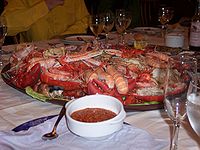
Photo from wikipedia
Dried seafood products are one of the most popular seafood items in Thailand. This study was divided into two experiments. In first experiment, a survey in intrinsic and bacteriological characteristics… Click to show full abstract
Dried seafood products are one of the most popular seafood items in Thailand. This study was divided into two experiments. In first experiment, a survey in intrinsic and bacteriological characteristics of twenty dried seafood products distributed in Chon Buri province, Thailand was performed. Values of water activity, pH and NaCl content were 0.35±0.01–0.72±0.00, 5.47±0.03–9.24±0.01, and 0.66±0.06–2.26±0.03%, respectively. Based on the Thai regulatory standard, half of dried seafood products contained total viable count over acceptable level. Predominant isolated bacteria in dried seafood products were Staphylococcus spp. (39.7%), Bacillus spp. (30.1%), and Pantoea sp. (19.2%). Foodborne pathogens, i.e., B. cereus and Salmonella enterica serovar Weltevreden were found in dried seafood products. In second experiment, two forms of antimicrobials (concentrated (CBV) and partially purified (PBV) substances) prepared from B. velezensis BUU004 and two commercial preservatives (nisin and lactic acid) were introduced into crushed dried seasoned squids to investigate inhibitory activity against pathogens, B. cereus TISTR 687, S. aureus ATCC 25923, Salmonella Typhimurium TISTR 292, and Escherichia coli ATCC 25922. PBV had broader antagonistic activity than CBV, nisin and lactic acid against tested pathogens. Scanning electron microscopy analysis represented bacteriostatic action of PBV on tested pathogens through cell lysis evidenced by an irregular cell shape along with pore formation on cell membranes. Our study demonstrates that PBV has a preservative potential to control pathogen growth and improve biosafety of dried seafood products.
Journal Title: ScienceAsia
Year Published: 2019
Link to full text (if available)
Share on Social Media: Sign Up to like & get
recommendations!